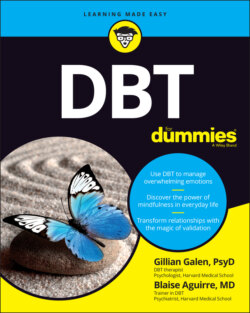Читать книгу DBT For Dummies - Gillian Galen - Страница 40
Incorporating Dialectics
ОглавлениеThe fundamental principle underlying the practice of DBT is the recognition of and emphasis on the dialectical process. The dialectical philosophy at the core of DBT is that seemingly opposing experiences such as thoughts, emotions, or behaviors can coexist, and both make sense. In other words, two ideas that are seemingly in complete opposition to each other can both be true at the same time. This requires that a therapist and a patient be able to look at a situation from multiple perspectives and find a way to synthesize the seemingly opposite ideas.
Within this framework, reality consists of opposing forces that are in tension, not dissimilar from a game of tug-of-war. As it pertains to therapy, in many cases the push to apply change-oriented treatment strategies often creates a resistance to the recommendations. The therapist pulls in one direction and the patient in another. This is because the prospect of facing the emotional turmoil and suffering that many people with conditions like BPD experience during therapy feels more painful than they are willing to bear. Dialectical philosophy also recognizes that opposing forces are incomplete on their own; you can’t have a tug-of-war with only one team.
Practitioners noted that it was by moving into a collaborative and accepting stance, rather than one solely focused on trying to get their patients to change, that the possibility of change occurred. And so, when the therapist balances and synthesizes both acceptance and change-focused strategies in a compassionate therapy, the patient experiences the freedom they need to heal. In many cases, prior to DBT, patients experienced the opposite. They either noted locking horns with their therapists, who insisted that the patients had to change, or they experienced passive, though caring, therapists who simply listened and didn’t offer ideas that could help. In some cases, individual therapists would swing between the two extremes, another style that was unhelpful to patients who themselves would tend to swing between extremes.
Another way that this manifested in traditional therapies is that frequently the therapist would feel that their formulation of the patient or their interpretations of the patient’s behavior was “right.” In DBT, the therapist lets go of the need to be right and is open to the idea that there are other possibilities in the moment. Finally, in DBT, there is an emphasis on moving away from a rigid style of therapy, and so there is often a lot of movement, speed, and flow within a therapy session. This is achieved by the therapist using various strategies to increase or decrease the intensity, seriousness, lightness, or energy of the therapeutic interaction, and then in so doing assessing what works best for any one particular patient, rather than assuming that a single style works equally well for all patients.
The following sections delve more deeply into the dialectical process. Flip to Chapter 15 for even more information.
